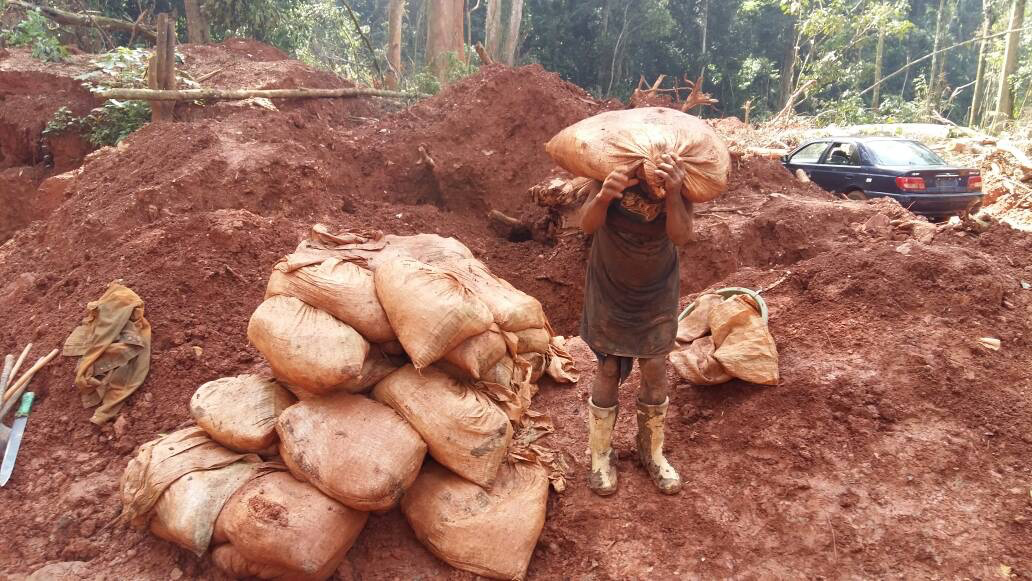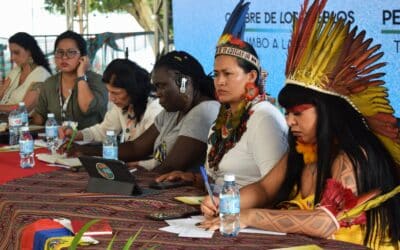This issue of Forest Cover, Whose Land, Whose Forests? describes the harm that extractivist projects like mining and monoculture tree plantations are doing in communities across Africa and Asia and makes the connections between colonialism, capitalism, and patriarchy.
Produced by the Global Forest Coalition’s campaign on Extractive Industry, Tourism and Infrastructure (ETI), it includes six case studies based on on-the-ground research by several of our member organizations in very different parts of the world. But they have a common problem: the forest ecosystems and landscapes that have long been important to Indigenous and local communities are threatened by resource extraction activities by corporations, often with the support of governments, putting profits over local priorities and threatening the environment and social fabric.
This issue asks the questions, What is valuable, and for whom? Whose land and forests are at stake? How did this system arise, and what are its specific consequences today, particularly with regard to gender?
The theoretical and conceptual framework for this issue is set out in the introduction, which defines extractivism and takes a long view of its origins. It also describes the feminist perspective that we take on the issue of extractivism and that inspired the research. Six case studies are included that tell about extractivist projects in India, Armenia, Kyrgyzstan, Ghana, Liberia, and the Democratic Republic of the Congo. The conclusion brings together the various strands of these specific examples of extractivism and their impacts on women and communities and provides a critical analysis of this system, by which those who benefit the least from global capitalist flows have to make the biggest sacrifices.
In a context of record forest loss, with a climate and biodiversity crisis that requires urgent action, it is essential to look at the global and the local in tandem and to really see what solutions are out there if we listen to local perspectives and knowledge.
Read the full text below or download the report using the links here:
English: Web quality | Low resolution
Spanish: Web quality | Low resolution
French: Web quality | Low resolution
Russian: Web quality | Low resolution
Forest Cover 67: Whose Land, Whose Forests?
The Gendered Impacts and Colonial Roots of Extractive Industries
Contents
- Introduction
- Armenia: “Our water is our gold”: The residents of Jermuk are rising up in protest against a mining project destroying their city
- Ghana: “I am the man, you must listen to what I say”: How Industrial and Artisanal Mining are Deepening Existing Gender Inequalities in Ghana
- India: Forest people need trees, not coal: The impacts of mining on biodiversity in Hasdeo Arand, India
- Kyrgyzstan: “In extracting gold, we lose something more valuable”: Preserving the natural heritage of Kassan-Sai in Kyrgyzstan
- Liberia: Agro-industrial monocultures as a form of extractivism: Oil palm in Liberia
- DRC: Violence against women, forced child labor: The realities of industrial mining in the DRC
- Fuelling Patriarchy and Poverty: The Role of Extractivism in the Destruction of Forest Ecosystems
Introduction
By Allie Constantine
“The day we believe that trees, animals and all things have a spirit, we will begin to respect nature. If we do not reach this conclusion, if we continue to believe that trees only have a monetary value, we are going to eradicate Mother Earth.” — Faustino Alba

Alongside the destruction of biodiversity and the land, extractive industries harm social structures and knowledge systems. Rivers and freshwater sources, kin of many communities who still remember that water is life, are irreversibly poisoned by industrial chemical runoff. Plants and animals that have evolved to coexist with the surrounding forests and communities are destroyed or displaced, leaving soil that is devoid of the minerals necessary for vegetative life. Often, the most economically valuable lands are the first to be used or destroyed, leaving less “valuable” lands for marginalized communities. Because of economic marginalization and forced displacement, communities that reside in these places are often dependent on non-economic relations with these places, such as forests, for survival. These non-economic relations include gathering wood, fruits, seeds, medicinal plants, which disproportionately affects women who are often the ones to engage in these activities.
Further, as extractivism uses up land and makes it uninhabitable, it moves on to the next place to use up, leaving fewer sites that can be safely inhabited. Women and gender-diverse people, who are frequently knowledge keepers of their communities, must often leave their ancestral homes to keep their families alive, risking the loss of generational stories which are interconnected with the land. Women and people of marginalised genders are often murdered for defending their homes, risking their lives on the front lines of environmental protection for a liveable planet for all. Further, violence stemming from industry disproportionately affects women and Indigenous activists, who are already made vulnerable through systemic inequalities.
Ultimately, all beings rely on forests and forest diversity for the continuation of life on Earth. Despite UN Sustainable Development Goal 15 outlining the need to protect and restore terrestrial ecosystems and forests, as well as halt and reverse land degradation and biodiversity loss, extractivism and forest loss continue. Forests shelter most of the planet’s terrestrial biodiversity, and while deforestation is slowing somewhat, forest cover is still diminishing at rapid rates despite increasing knowledge around the importance of biodiversity and mitigating climate change. Furthermore, most extractivist systems deplete forest resources either directly or indirectly, which means that as humans continue to gather resources, forests will continue to be impacted. But “green” and “sustainable” terminology, which is increasing in recent years, tricks people and does not reflect the rapid decrease of green on the lands they mine and render uninhabitable for these “solutions.”
Indigenous communities, the majority of whom live in or near forests and rural areas, are stewards of an estimated 80% of the world’s biodiversity. In contrast, the biggest threat to biodiversity is extractivism, including mining, tree plantations, oil and gas exploration, and large-scale monocultures. Those who are directly impacted by the detrimental effects of extractivism and climate change are Majority World communities, women and gender-diverse people, and those who are excluded from global and local decision-making processes. The case studies here show that frequently there is no fair consultation with these communities—if any at all—and community divisions are created from the false promise of prosperity.
This report, produced in collaboration with Global Forest Coalition’s (GFC) campaigns on Gender Justice and Forests and Extractive Industries, Tourism, and Infrastructure, as part of our contributions to the Green Livelihood Alliance (GLA), highlights the voices of those who are most affected by extractivist processes. This includes those who are protecting our planet now and for future generations and whose accounts illustrate the gendered impacts of extractivism on forest ecosystems and the livelihoods of people who depend on them. Ultimately, the objective of the research is to analyze extractivism through a feminist lens and examine the impacts of extractive industries on different genders within forest communities and forest-dependent groups.
The approach and methodology
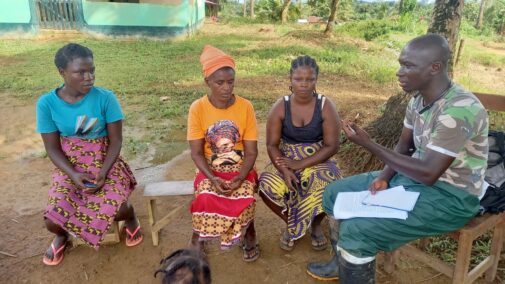
GFC further adopts an ecofeminist perspective informed by feminist political ecology (FPE) through how these lenses explore the connections between the oppressive domination of “women” and “nature”, which is seen as ‘feminine’ and sacred by indigenous peoples, but degraded to ‘inert’ thing, and therefore as ‘inferior’, by extractivism. Under this logic, nature can be used and dominated, this logic is used to discriminate against women and gender non-conforming people, as well as those who deviate from the acceptable norm that stems from European whiteness and maleness. Both “women” and “nature” are seen as being “less than” men and industry, and thus the dominant system sees justification for their exploitation of both in similar ways. Further, ‘gender’ as it is understood in Western cultures was partly a colonial import that was used to destroy Indigenous cosmologies and communities in order to build the “civilized” West. Through the introduction of “feminized” and “masculinized” societal roles and the violent dismissal of deviation from these imposed binary gender roles, the control of women and gender-diverse people spills over into extractivism in many ways. FPE, therefore, critiques these patriarchal and colonial Western views (such as assumptions, distinctions, and theories). These frameworks work to co-create alternatives and solutions to such patriarchal views and focus on local resistance through building place-based alternatives.
Women, in all of their diversity, especially Indigenous women, children, youth, and Elders from forest communities, face the earliest and most severe effects of extractivism, and few of the benefits. However, though these disparities are increasingly acknowledged, there are often no consistent gender responsiveness guidelines or impact assessments implemented. Further, assessments of the differentiated impacts of extraction often engage in essentializing and patronizing language, homogenizing categories like “women” and “LGBTQI+,” or referring to communities as passive victims. While the term “women” is used throughout this report, we acknowledge that it is an expansive term that encompasses many different experiences and intersecting identities. When “women” is used alone, this is because the data did not specify other genders—as we are reporting and working with other communities, we want to avoid filling-in information or speaking over these communities.
Importantly, the intersectional lens within gender reporting explores how inequality and discrimination are all part of an intricate web of harm that cannot separate gender from race, class, ethnicity, religion, or others. It is not an ‘add-on’ model that is needed, but one that recognizes a “multi-dimensional” and “multi-scalar view.” GFC recognizes that gender analysis must be accompanied by real change that addresses power imbalances and gender stereotypes on multiple levels.
We also recognize that cooperation and co-construction of knowledge are necessary to facilitate change. Co-construction of knowledge enables different research disciplines, non-academic ways of knowing, locally-based knowledge, and lived experience to coexist and recognizes all as necessary to facilitate social learning and sharing.
For this issue of Forest Cover, GFC members interviewed communities that are facing extractive processes to examine power differentials and analyze the effects on people and the environment. Literature analysis and secondary quantitative information are used to support GFCs and respondents’ reporting.
Limitations
There are unavoidable limitations that were encountered. Firstly, there is a lack of gender reporting regarding forest communities in general, and impacted communities also face social barriers to sharing information. This includes cultural and socioeconomic barriers, violence at different levels, the distrust of organizations and reporting due to historical wrongs, geopolitical factors, and others that may hinder certain groups from responding. Moreover, GFC members were sometimes unable to travel to certain communities due to safety concerns, including heavy rains and travel restrictions due to COVID-19. We attempted to address this by including a culturally sensitive questionnaire to communities so that they can address the questions as they see fit.
What is extractivism?
The focus of this issue is extractivism, which refers to the process of extracting large volumes of natural resources for use by export markets. Extractivist systems are entangled with global capitalism at both global and local levels and can be publicly, privately, or state-owned. Furthermore, extractivism is a process that has been created and perpetuated by historical and contemporary forms of colonization, and the concept has existed for over 500 years. It is part of an intricate web of mentalities, discourses, practices, and power differentials that contributes to the destructive organization of life through hierarchization, depletion, destruction, and non-reciprocity.
In other words, the process of extraction cannot be viewed solely at its base level of “resource extraction” but rather, must be seen through the hierarchies of power it generates and perpetuates, including through gender oppression and continued colonization of Indigenous lands. The term encompasses historical colonization (including chattel slavery) and neocolonialism, including the plundering, accumulation, and concentration of capital for some, and total devastation and poverty for others, all of which have influenced the development of global capitalism.
Extractivism has historically been a means of establishing power and wealth for certain nations and groups of people, creating systemic hierarchies between geopolitical regions and categorization amongst people by race, gender, class, ethnicity, caste, etc. From mass exploitation of resources and people through colonization, patriarchy, and exploitative capitalism (all of which continue today), to wiping out entire ecosystems to extract raw materials, to desecrating Indigenous groups’ sacred sites, extractivism has a broad reach.
Globally, there is a correlation between poverty and natural resource availability: countries that rely on raw materials exports tend to be less wealthy. Nations that have faced colonialism directly and are forced to continue to provide for former and current colonizers through global capital accumulation are impacted most severely. For example, with settler colonial Canada’s many mining operations abroad (in Africa, for example) and within Canada itself, Canadian companies profit immensely, while the countries they operate out of, as well as the Indigenous communities they impact within Canada, are left in extreme poverty and subjected to egregious working and living conditions. Importantly, all extractive industries impact forests and forest communities in some way. While logging is frequently examined as having the biggest impact, extractive infrastructure of all forms directly and indirectly affects forest ecosystems and the communities within and around these forests.
With extractivist processes, violence inevitably occurs, and this violence affects women and gender-diverse people disproportionately and permanently in multiple ways. This will be explored further in the case studies in this report.
As already mentioned, women and gender-diverse people experience more sexual violence, domestic violence, and racism with the introduction of extractivism. For example, reports show that there is an increase in sexualized violence when work camps are stationed near remote communities, specifically in Indigenous communities. Further, masculinities that are shaped through patriarchy with the violent introduction of colonial gender roles from extractive industries, often create violence within communities and increased substance abuse. Employment opportunities that come into communities often segregate tasks by gender, and the “hard labor” involved in oil, mining, logging, and more is disproportionately assigned to men, while women are left with difficult domestic tasks as well as unpaid domestic and community labor and dangerous forms of sex work and trafficking. Industry led by men tends to alienate women and other genders from participation through enforcing and solidifying binary gender roles. Moreover, there is often a lack of gender-responsive community consultation, as evidenced in the case study of palm oil plantations in Liberia.
Further, there are disproportionate effects on reproduction created through the use of chemicals and heavy metals that affect women and children more negatively, as seen in the Kassan-Sai gold mining operations examined in this publication. Women and gender-diverse people frequently lead the resistance to these damaging industries, putting them at greater risk of targeted violence and murder.
Importantly, not all women are impacted by extractive industries equally. According to a UN report, 69% of the 331 frontline defenders reported murdered (this does not include the many others ‘missing’ or unreported) in 2020 were defending Indigenous, land, and environmental rights. 25% of those murdered were Indigenous (in juxtaposition to only 6% of the global population being Indigenous) and between 2015 and 2019, more than one-third of frontline defenders killed were Indigenous. Additionally, Missing and Murdered Indigenous Women, Girls, and Two-Spirit (MMIWG2S) people is a global issue, and overall, Indigenous women and gender diverse people face increased risks of violence in general. Extractive industry increases this risk.
Further, Indigenous women often face the compounded burden of defending the survival of their cultures and communities in the face of ongoing colonialism and displacement from community, which makes resistance due to the threat of violence more precarious. They are subjected to multiple forms of discrimination. Forest and other rural women face the compounded issues of lack of access to healthcare and safety, increased trafficking, poverty, and more. Overall, the gendered impacts of extractivism on forest communities need to be examined in order to gain a complete picture of just how detrimental these processes are.
Forest communities and Indigenous Rights
As discussed previously, Indigenous Peoples globally steward the majority of biodiversity (most of which is within forests), helping to guard our planet against increasingly volatile changes that have been caused by human-driven factors. While Indigenous people are historically not responsible for the negative impacts on the environment, they are some of the first to feel the effects of climate change through increasing temperatures, wilder storms, loss of natural habitat, and more.
Furthermore, Indigenous people face greater violence than most other groups at the hands of governments, with high rates of incarceration. Indigenous women and gender-diverse people specifically face some of the highest rates of gendered violence. Indigenous people often live within or rely on forests for their livelihoods and survival, and their culture, language, and history are tied to these lands, and hence knowledge systems are at risk as extractivism destroys forest communities. Forced displacement due to extractivism means a loss of culture, connection to land, and identity.
Importantly, Indigenous relationships to “nature” differ from the exploitative forms created through capitalist extraction. For example, in the case in Chhattisgarh discussed in this report, Indigenous people view the trees as deities, which they worship in places known as Devgudis. The connection to the natural world is spiritually and culturally significant, and many refuse to leave despite the destruction of mining. Western conceptualizations of “resources” that simply seek to accumulate materials sever people from sacred and land-based knowledges, creating deep cultural alienation. This is a fundamental difference in how life is conceptualized that allows some to see it as something to be used, while others understand that we are inherently part of living ecosystems.
The 1992 Indigenous People’s Earth Charter states: “We feel the Earth as if we are within our Mother. When the Earth is sick and polluted, human health is impossible. To heal ourselves, we must heal the planet, and to heal the planet, we must heal ourselves.” The sense that nature has agency is reflected in Indigenous peoples’ struggles to reclaim lands they historically stewarded. If extractivist processes, companies, and states unilaterally go into Indigenous territories, they are undermining this.
Given that most intact biodiversity is located where Indigenous people are, reframing extractivism’s distorted take on life is necessary. To shift away from exploitative extraction, we need to adopt “nature-derived” guidance that includes spending deep time in relationship to the land, learning from it, and engaging with stories connected to it. This is something Indigenous cultures have been doing for millennia. Returning to a respect for nature necessitates gender equity across all locations, as the exploitative form of viewing women and nature as something that can be dominated go hand-in-hand. Viewing gender outside of the colonial binary and returning to gender expansiveness outside of oppressive gender roles can help heal oppressive understandings of “women” and “nature.”
Perspectives like the Rights of Nature and ‘Land Back’ movements are imperative to heal human relations with non-human kin. They posit that the land is autonomous and self-determining. and that harmony and reciprocal relationships with nature are necessary to shift relationships with land from something to be exploited to a more holistic understanding of human-nature relationships.
Many international frameworks and bodies have begun to recognize this. For example, the World Parks Congress (WPC), the largest gathering related to the future of protected areas globally, has recognized the rights of Indigenous and local communities as imperative. Incidentally, protected areas have often left Indigenous people out of processes, displacing them from territories they traditionally stewarded. The rights and care of Mother Earth were brought up by Indigenous participants at WPC in 2014, who argued that Earth should have intrinsic value as a whole rather than through parceled and isolated protected areas. Furthermore, WPC deemed Indigenous rights to their territories as a prerequisite to Earth’s protection. The conversation needs to start here, rather than viewing Indigenous and women and gender-diverse people’s involvement as an add-on.
While none of these are legally binding, they can be used to inform future policy and shift paradigms of conservation from top-down to grassroots, led by Indigenous people, women, and gender-diverse people, and others who are at the forefront of environmental protection.
Cases
This report presents cases from six forest or forest-dependent communities facing extractivism. Their stories and knowledge are imperative to better understand how extractivism affects these communities and others in multiple ways, and how each case engages with gendered consequences of extractivism.
The cases include coal mining in an Indigenous tribal community of Chhattisgarh, India, industrial and artisanal mining in the Democratic Republic of Congo;open-pit gold mining in Kassan-Sai in Kyrgystan, the impacts of mining and logging on the forest communities around Accra; palm oil plantations in Liberia; and, and copper and molybdenum mining in the Lori region of Armenia.
All of the cases illuminate the pressing issue of extractivism within the local communities they impact, highlighting the experiences of women and Indigenous people, which is necessary to understand how the conversation around extraction and oppression can be shifted to put their needs and solutions at the center.
“Our water is our gold”: The residents of Jermuk are rising up in protest against a mining project destroying their city
By Ángel Tuninetti in collaboration with Armenian Forests NGO

Mining is not a significant source of employment in the country, as it provides just about 1% of jobs, and mostly for men. It also harms other economic sectors by changing land use patterns and polluting agricultural and touristic areas. Many of the affected industries, such as food canning, fruit drying, health spas, and tourism, are ones that traditionally employ more women. This worsens gender inequalities and women’s economic, social, and political vulnerabilities.
The town of Jermuk takes its name from its greatest wealth—it means “warm spring water” in Armenian. This water has made Jermuk famous since medieval times; it was first mentioned by historians in the 13th century. But now, this invaluable ecological heritage is under threat. The Amulsar Gold Mine Project, owned by Lydian International Limited, currently in its initial stages, will destroy biodiversity, pollute the air and water, and affect the livelihoods of the population.
The forest setting
Jermuk is located in southeastern Armenia and is surrounded by forested mountains and meadows on the banks of the Arpa River, at an altitude of 2,100 meters (almost 7,000 feet). Its economy is based on tourism and mineral water. Numerous springs of hot and cold groundwater are used for drinking and for therapeutic purposes.
The city has an area of 2,100 hectares, of which only 100 hectares are developed, and 1,600 hectares are forested, providing an apt setting for health-related tourism and for biodiversity to flourish. These forests are now threatened by mining, as are many other natural spaces in Armenia. Armenia is a mountainous country with a total forest cover of only 8%, most of which lies north of Lake Sevan, along the border with Azerbaijan and Georgia, and on the southern border with Iran.
According to Armenia’s Forest Code of 2005, forests are largely protected and only sanitation cutting is allowed. But urbanization, mining, and illegal logging are rampant all over the country. The Forest Committee, created in 2018 under the Ministry of Nature Protection, allows around 30,000 cubic meters of wood to be cut each year for sanitary purposes, but about 800,000 cubic meters are illegally harvested due to the high price of electricity and gas and high levels of poverty, as well as for production of furniture and other goods.
Threats due to mining
Mining is one of the main culprits of deforestation in Armenia, as the country is rich in minerals, including copper, gold, molybdenum, lead, zinc, and silver. There are about 400 mines under production, including 22 metal mines. Metal mining accounts for only 2.8% of the Gross National Product, far less than agriculture (40%) and tourism (15%). However, ore accounts for about 60% of total exports, and a single company accounts for 90% of mining production: Zangezur Copper and Molybdenum Combine.
Amulsar
The Amulsar Gold Project is planned in Mount Amulsar, in the Vayoc Dzor region, an area located between two water reservoirs and two rivers, the Arpa and the Vorotan, which are the watershed basin of Lake Sevan. The project is developed by Lydian International Limited, a U.S.-based multinational corporation with financing from the European Bank for Reconstruction and Development (EBRD) and the International Finance Corporation, a branch of the World Bank. Although mining is not allowed in the Sevan lake watershed basin, the Amulsar Project obtained mining permits issued by former authorities suspected of corruption. The new authorities are afraid to cancel the permits, concerned that the company would seek international arbitration. Furthermore, there is a tendency in the current government to support mining and have ties to Lydian, making it easier to obtain permits.
The project is located in a 150-hectare plot of former agricultural land in the village of Gndevaz. The land privatization and further acquisition by Lydian became a criminal case, as community leaders privatized public lands and sold them to family members at low prices, to be sold later to Lydian with huge profits, as the newspaper Hetq has reported.
The company has been working on the project since 2006, but no gold has been extracted yet; in actuality, they only sold shares on the Toronto Stock Exchange during this period of time. However, even when there is no production, the environmental damage has begun, caused by the prospecting and construction work at the mine site: radiation levels have increased, and so has air and water pollution. Additionally, biodiversity has been affected, people have lost their agricultural lands, and human health has been harmed.
The company filed for bankruptcy, the main equipment was sold, and now they want to sell the mining permits and leave Armenia. This follows a common pattern: many new mines exploit rich veins for several years, only to later file for bankruptcy and leave the mine without paying taxes and salaries, and without providing environmental compensation and recultivation. If the company finds a buyer, the new owner usually restarts the mining.
Lack of regard for health and nature
If the mine is restarted by a new company, the project will be extremely destructive, not only for Jermuk, but also for Armenia and the whole region. The pollution created by acid drainage will reach the Arpa and Vorotan Rivers, and therefore Lake Sevan, destroying freshwater resources in the region. In addition, the high demand for water for mining will dry up water wells and springs, which are currently used for drinking, health treatments, and agriculture. Radiation and air pollution levels will rise, creating health hazards and harsh living conditions at high altitudes.
Since the livelihood of the area relies heavily on tourism and its famous medicinal waters, the impact on the economy will be devastating. After all, who wants to relax in a place where the hot springs are disappearing, the air is polluted, and with a background of mining noise? Where the historical monuments from the Stone and Bronze Ages have been destroyed? Where forests have been cut and biodiversity has been affected?
Regarding the impacts on locals and their own perspectives, besides the illegal obtention of the permits, there have been many human rights violations: no public hearings were held, nor were there any types of consultation with community members. The project was initially kept secret from residents, who have been advised and informed of the consequences by environmental activists and NGOs.
Very few residents will benefit from the project. The current employees are mostly from other regions, with temporary and low-wage jobs that pay about $300 a month. The situation is worse for women, who already earn 20-33% less than men on average in Armenia. Women from Jermuk interviewed for this case study stated that their job opportunities will be seriously affected by the mining since they mainly work in service industry facilities like health spas, hotels, tourism, and other service industries.
When construction began, the company rented a number of health spas and hotels for foreign specialists and workers from other regions, and all of the staff lost their jobs and livelihoods. The number of tourists visiting Jermuk has already diminished, damaging the local economy. Since the tourist season is only two to three months long, many residents rent their apartments to tourists during those months and expect to live on that money all year round.
Another source of income for women is harvesting medicinal plants, berries, mushrooms, and other edible plants from the fields and forests. As a result of Lydian’s construction at the mining site beginning in 2016 operation of the mine, all the fields and the forest began to be polluted with dust, making those plants not suitable for human consumption. This would worsen considerably if the mining project goes ahead.
The situation is no better in the village of Gndevaz, where the project is taking place. There, most of the apricot orchards have been cut down, or the dust from the construction has ruined the crops, a loss that affects mostly women, as they expressed in interviews.
During the construction, the company damaged the drinking water line of Gndevaz on two occasions, and people were left without drinking water for several days. On a fish farm, all fish died because polluted waters reached the Arpa River. The company did not compensate anyone.
Local perspectives and resistance
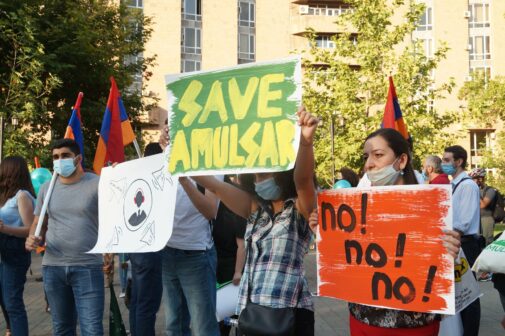
Aram Hakobyan, the owner of Jermuk fish farm, said: “As a result of an accident in Amulsar during construction, water contaminated with harmful substances spilled into the Arpa River, where our fish farm is located, and all the fish died. Our business suffered a lot of damage, and the company did not compensate for the damage.”
Hasmik Sargsyan, a doctor who works in the health spa, explained how, according to her experience, air and water pollution will have an impact not only on the health of the local population, but also will affect the future of Jermuk as a tourist destination. Larisa Rogova, a tourist from Russia, expressed the same concerns, stating that she will not return to Jermuk if there is pollution.
This lack of regard for human well-being and nature is not new. The mining contract does not include any compensation or social responsibility for the damages produced by the project. In other mining regions, tests found heavy metals like arsenic, mercury, and selenium in water, soil, vegetables, and children’s hair. If the extraction of minerals begins in Amulsar, the same effects are to be expected.
The impacts on the residents’ well-being are not only related to health. In the Environmental and Social Impact Assessment, the company mentioned that there will be an increase of criminal activity and sexual harassment in Jermuk due to the large numbers of male workers that will come from other regions, affecting families, women, and youth.
Legal challenges
The struggle against the Amulsar Gold Project continues, led by the environmental NGO Armenian Forests. Director Nazeli Vardanyan, an environmental lawyer, says: “Members of the NGO and specialists regularly meet with members of the affected communities, raise awareness about environmental and social risks, explain their rights, and provide them with a mechanism for participation in the decision-making process. We created active groups to involve women and youth in decision-making and protect their rights. We also protect their interests in the courts.”
“As a result, there is more community participation in the struggle for their rights and protection of the environment. Petitions have been drawn up to make these communities sustainable economically without mining in four communities. Some 12,000 residents signed, and local authorities accepted their demands in their decisions. On behalf of the residents of Jermuk and Gndevaz, we filed two lawsuits against the Ministry of Environment and Ministry of Territorial Development and Infrastructure to annul the license and decision of the Environmental Impact Assessment. For two and a half years, the roads to Amulsar were blocked by residents. The company has initiated strategic lawsuits—civil, administrative, and criminal cases against activists and community members.”
It is important to document cases of resistance, collecting life histories of local leaders engaged in the resistance. This will allow us to see how different social groups and genders develop different strategies to respond to the adverse impacts of an extractive activity—communities are not passive actors resigned to their fate. They are actors engaged in individual or collective forms of resistance against extractive activities. These struggles sometimes take place amid confrontation, persecution, and even assassination of environmental human rights defenders.
It has often been said that the wars of the 21st century will be fought over water. Can governments and business people be so ignorant as to destroy this precious resource for temporary wealth from some metal? As they chant in their protests, the inhabitants of Jermuk don’t need gold: “Our water is our gold.”
“I am the man, you must listen to what I say”: How Industrial and Artisanal Mining are Deepening Existing Gender Inequalities in Ghana
By Ángel Tuninetti in collaboration with The Development Institute, Ghana
Only 70 km from Accra, the capital of Ghana, lies one of Africa’s most biodiverse ecosystems: the Atewa Range Forest Reserve. The reserve was created in 1926, is spread over 123,000 ha. (475 square miles) in size, and is home to at least 1,134 species of plants, 239 species of birds, 573 species of butterflies, and about 70 species of mammals, seven of which are listed as ‘Critically Endangered and Vulnerable’ on the IUCN Red List. It is demarcated as a Globally Significant Biodiversity Area and a Key Biodiversity Area.
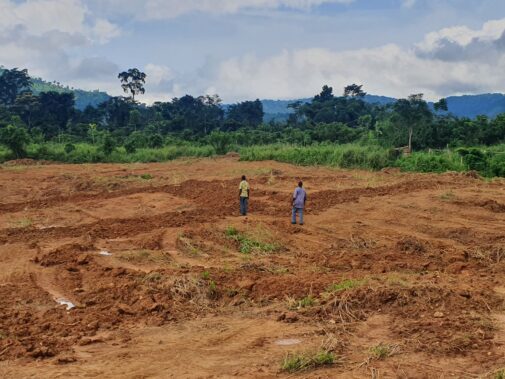
The Atewa mountain range is home to a substantial expanse of Ghana’s remaining forests. It feeds three major rivers (the Densu, Ayensu, and Birim) that provide water to Accra, and around five million people depend on these rivers for their drinking water. These forests are important as watersheds, carbon sinks, and as sources of livelihoods.
But the reserve is under siege: it contains significant bauxite deposits that have attracted the attention of international mining companies and also the Ghanian government, which is interested in developing the bauxite industry.
While industrial bauxite mining is the most significant potential threat to the Atewa Forest Reserve, it is not the only one. In recent decades, according to the District Manager of the Forestry Commission, it has been under pressure owing to a number of threats, such as farm encroachment (which has been restricted for a few years now), bushmeat hunting, illegal and unsustainable logging, and gold mining. Artisanal gold mining , though illegal, is very common in the region. This informal, unregulated practice is called galamsey in the local language and has a huge cumulative effect on the landscape. Concessional mining by medium and large-scale companies is also carried out on the fringes of the forest reserve, and affects numerous communities in the Atewa range.
To analyze the effects of mining on forest and biodiversity loss and on gender justice, GFC member The Development Institute worked together with A Rocha Ghana, a partner organization that works in the Atewa territory, to collect data by interviewing different stakeholders in the area, including members of the affected communities, local authorities, government agencies, and representatives of Kibi Goldfields Limited. More than 143 respondents participated in the activities carried out in late June 2022, including through one-on-one interviews, focus group discussions, observation and conversations.
Representatives of Kibi Goldfields Limited stressed their company’s importance in the region in creating jobs, training youth, sponsoring education, developing infrastructure, and supporting local governments. However, they recognized the impact that mining had in changing the economy of the area, destroying farming areas often without compensation, or offering compensation only to male heads of household, and not to the women who are often most affected by the environmental impacts. This assertion was made by both the District Manager of the Forestry Commission as well as the Mines Director of Kibi Goldfields Limited. Also, the influx of people from different areas and backgrounds poses challenges for women in the community in terms of safety and security. The women of the Adukrom community complained bitterly about increased crime, theft, and drug abuse among the youth in their community.
While the representatives of the company emphasized their commitment to the community, the testimonies of women and community leaders present a more nuanced perspective and are imperative to gain a fuller picture.
There is widespread acknowledgment among locals of the importance of mining (both traditional artisanal mining and industrial mining) in the economy. As one of the participants from the Nyametease Women‘s Group of the Akim Adukrom community said, “Mining is our means of livelihood and what we use to finance other things like farming and trading.” Members of this community expressed that mining has supported economic empowerment by creating jobs for young men and women, changing the local economy.
However, industrial mining has major drawbacks. The chief and elders of the same community explained that the arrival of industrial mining with the Minerals Genes Resources (MGR) company restricted artisanal galamsey mining and hence caused social problems such as drug abuse, alcoholism, petty thievery, and armed robbery.
There are additional problems brought forward by mining that affect the population as a whole, such as the contamination of drinking water, road clearing, the rising cost of living, children’s disrespect for their parents, physical hazards and accidents from pits and trenches, youth drug abuse, teenage pregnancies, sexual violence against women and other forms of human rights violations. With the influx of quick money from mining, there has also risen a tendency to spend money extravagantly and carelessly. Men tend to neglect their wives and children and even marry anew, which leads to interpersonal conflicts that easily escalate into violence. Adolescent pregnancy and school dropout rates for young women are very high, owing to their involvement with miners in the region.
Since galamsey is an illegal form of mining, law enforcement agencies arrest persons involved in it. Most of the arrests are done in team operations in which law enforcement officials chase the miners in the bush, causing injuries, and sometimes miners are shot. The women of Akim Adukrom stated that they are sometimes chased in the bush arrested and tortured by these task forces.
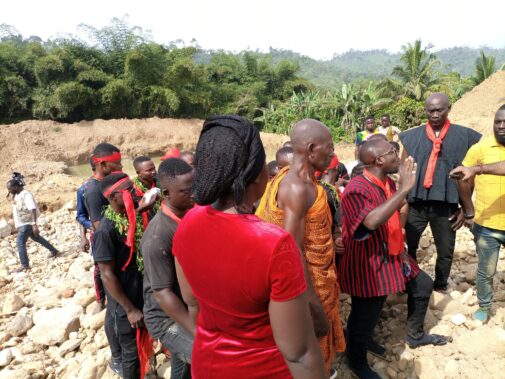
Women expressed concerns about a lack of access to information and decision-making power, which they said is curtailed by traditional laws and practices. In most communities, menstruating women are not allowed to work in the mining areas, or even fetch water from the river. As one of the participants expressed, women are perceived as inferior, and it is common to hear statements like “I am the man, you must listen to what I say.”
In addition to the above-mentioned livelihood concerns, Mr. Emmanuel Antwi, the District Manager of the Forestry Commission, and members of A Rocha Ghana, highlighted the risks posed by illegal mining and logging in the preservation of the forests and the watersheds.
As members of A Rocha Ghana expressed, it is necessary to look for alternative means of livelihoods for women, whose empowerment should be supported. For example, the Forest Forums, platforms for stakeholders set up at the District level within forest communities to guide and inform on the sustainable management of natural resources, should be chaired by women to promote their access to information and discussions on the importance of natural resources.
The Atewa Reserve is home to unique species of butterflies and endangered mammals like pangolins, and it is the source of water and sustenance for millions. Bauxite, which is used to make aluminum for products like cars, is such a lucrative resource that it has attracted deals with countries like China, and government representatives continue to try to woo investors. There have been efforts by civil society locally and internationally to call for greater protection of the Atewa range and address rights violations, and the situation remains critical. The testimonies of women interviewed for this research suggest that gender justice must be part of effective forest protection measures.
Forest people need trees, not coal: The impacts of mining on biodiversity in Hasdeo Arand, India
By Ángel Tuninetti in collaboration with Navrachna Samaj Sevi Sanstha, India
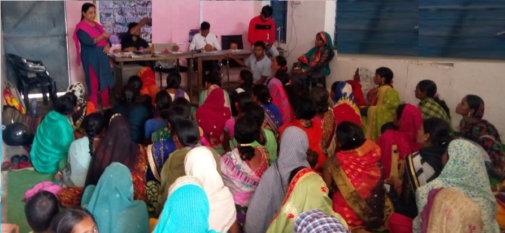
Several forest-dwelling communities, including the Gond tribe, India’s second-largest Scheduled Tribe, live in the Hasdeo Arand region. They are dependent on forest produce for food and medicines, including grains, seeds, tubers, flowers, fruits, and roots. Their income comes from timber, leaves and grasses, with which they make ropes, mats, brooms, and baskets.
Now, displacement due to mining projects approved by the government and ensuing deforestation threatens the freedom and livelihoods of tribal communities in the area. They worship trees as deities, and are therefore unwilling to leave the forest which has many devgudis—sacred sites.
The Parsa mining project
The reason for this displacement is the Parsa mining project, which has so far resulted in the destruction of some 40,000 trees, and will eventually deforest 841 hectares and displace over 700 people. Without paying heed to the devastating consequences for the forests and their people, the Chhattisgarh government is pushing for the expansion of coal mines, claiming that coal is necessary to guarantee the demand for electricity.
There are several other coal mining operations in the region in different phases of exploitation. The resistance against mining began more than a decade ago, and protests escalated in March 2022, when the Chhattisgarh government allowed the second phase of coal mining in an area of 1,136 hectares in Parsa East-Kete Basan (PEKB) coal mine. The first phase of PEKB coal mining began in 2013 and two villages, Kete and Basan, were affected by the mining operation. The protests forced the authorities to put a hold on further mining by the Adani Group, the multinational conglomerate responsible for the operations.
Meanwhile, the Chhattisgarh government gave Stage II approval for another coal mining project in Parsa. The Rajasthan government is also trying to speed up the process of obtaining final clearance for a third project, Kete Extension, because Rajasthan is dependent on Chhattisgarh coal for its electricity production. In March, Rajasthan Chief Minister Ashok Gehlot told the media that if coal supply is reduced, electricity supply will also be affected in Rajasthan. He said, “The people of our state are looking towards Chhattisgarh for early clearance of these projects.” Activists claim that over 200,000 trees will be cut during the projects. Deforestation started within a month of final approval to the Parsa coal block.
But Alok Shukla, the convener of the Chhattisgarh Bachao Andolan, questions that number. He said: “So far, around 300 trees have been felled in Janardanpur of Surguja district in Chhattisgarh.” The tree cutting has been suspended as of now due to continuous protest by villagers.
A joint study by the Indian Council of Forestry Research and Education in collaboration with the Wildlife Institute of India recommends coal mining but admits that “Cumulative impact of displacement due to mining operations will have a serious impact on the community in the form of loss of livelihood, identity and culture.” This is because 90% of the households are dependent on agriculture and forest produce for their livelihoods.
Kete Village was completely displaced in 2016, and a population of nearly 600 moved to nearby Basan village. Ramlal Kariyam, a local who has been fighting against the mine, says, “Those who have been displaced are facing trouble sustaining their livelihood. They are wandering from one place to another.”
The forest is adjacent to Lemru Elephant Reserve, an area with a high level of Human-Elephant Conflict (HEC). More than 60 lives are lost each year due to trampling, especially during the collection of flowers and fruits of the Mahua (Madhuca longifolia), a tree of great cultural, economic, and symbolic importance for the tribals of the region. People have been forced to stop collecting Mahua due to the high incidence of fatalities. Additionally, mining operations create big pits that disturb elephants’ migratory routes and put them in conflict with residents.
Rights violations

Members of the community have also been misinformed regarding the compensation they are supposed to receive, which started at 500,000 rupees per hectare, and then was raised to 1,000,000, even though the government rate is 1,500,000 per hectare. Job promises were not kept either: local residents were hired in low-wage positions and promised job security for three years, but some were fired after just six months.
The rapid expansion of industries and mines in tribal areas was followed by a boom in urbanization and a massive influx of outsiders, causing the displacement of Indigenous People, who were forced to migrate to other regions in search of means of survival. The displacement can also occur through indirect pressure from the establishment of industries, mines, and towns, as well as the pollution of air and water.
There are health problems associated with displacement, and pollution affects all resources: air, water, animals, fishes, plants. etc. People are experiencing a slow and agonizing death due to contamination of their environment.
Impacts on women
Women are the worst affected by mining and rarely receive any benefits from it. Women were never consulted during planning nor during the payment of compensation, and most of them do not know how much compensation was paid. Women are the main force of non-timber forest products and fuel wood collection, and therefore deforestation directly affects their cash income. Besides, collecting firewood and clean water has become more difficult and arduous, and coal dust imposes an extra burden on house cleaning and respiratory health.
Women’s mobility in the villages is reduced with the influx of outsiders. The safety of women is compromised, and there is an increase in sexual abuse and alcoholism. Women hold a respected position in tribal societies, and there is no evidence of harassment of women in traditional practices. Mining erodes women’s authority in the family, causing the breakup of families and weakening of kinship ties, with the consequent loss of the security and safety created by those relationships. Women almost always lose their economic role when land is converted to mining. Employment provided by companies is rarely given to women, who are forced to give up their life of dignity to perform menial tasks in the industrial townships. Compensation or skills training are only available to men in the displaced villages, not to women. In short, women are severely affected socially, economically, and physically. With the shift from traditional to modern lifestyles, women struggle to adapt and face severe social and cultural exploitation.
Women’s rights and developmental potential within the extractive industry has led to continuous structural gender inequality. When a subsistence forest-based economy suddenly changes to a competitive cash-based economy, women suffer the most.
The result is gender inequality, the complete disempowerment of women, and a gendered shift in power relations within the area and within the affected communities. Their indigeneity is completely lost and traditional women’s institutions are dismantled, resulting in even greater socio-economic inequalities.
In the process of mining ‘development’, tribal areas are witnessing not development but the exploitation of people and nature through a process of colonialist and capitalist exploitation. The inherent brutality of industrialization—the plundering of mineral wealth, and the decimation of forests which provided much of the livelihood for their people—has not only reduced the inhabitants of these areas to poverty, but also brought the area to the brink of ecological disaster, one that can only be avoided with a continued resistance and activism.
“In extracting gold, we lose something more valuable”: Preserving the natural heritage of Kassan-Sai in Kyrgyzstan
By Ángel Tuninetti in collaboration with Public Foundation Ecological Movement, Kyrgyzstan
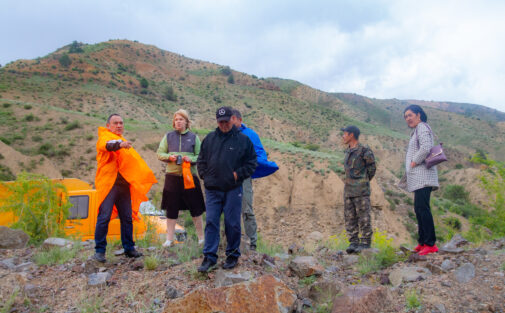
The Key Biodiversity Area of Kassan-Sai
A recent survey identified 32 Key Biodiversity Areas (KBAs) in Kyrgyzstan. Many of them are legally protected, but 14 KBAs do not have formal status and could be destroyed in the absence of conservation strategies and responsible safeguards from local communities.
The KBA of Kassan-Sai is a prime example. As an area that is not legally protected as national park or reserve, it is being threatened by gold mining operations in the Terek-Sai settlement. Three NGOs, with the coordination of the Global Forest Coalition (GFC), are working with local communities and supporting their struggles in defense of their environment and wellbeing.
The alpine forest ecosystem of Kassan-Sai is home to several animal species included in the IUCN Red List, such as the snow leopard (Panthera uncia), Egyptian vulture (Neophron percnopterus), and Menzbier’s marmot (Marmota manzbiery). It is also home to many species of plants, such as the endemic archa tree (Juniperus semiglobosa), Tien Shan spruce (Picea schrenkiana), tian-shan birch (Betula tienshanica), poplar, willow, sea buckthorn, elm, and many grassy mountain plant species typical for forest, subalpine and alpine zones. Three wild endemic fruit plants in the area are severely endangered: Niedzwetzky’s apple (Malus niedzwetzkyana), Sievers apple (Malus sieversii), and Korzhinsky pear (Pyrus korshinskyi). They hold genetic material that could be key to secure the future of cultivated fruits that are climate resistant.
This biodiversity is threatened by gold mining, an activity with a long history in the region. The most important records of ancient gold mining in the country were found in this very region, in the valley of the Kassan-Sai River, a place that is applying for status as a UNESCO World Heritage Site due to its historic and cultural value.
Terek-Sai gold mining project
The main threat to Kassan-Sai is the Terek-Sai gold mining project, which began in 1946. It is located within the KBA and has a severe impact on the environment, since gold in Kyrgyzstan is extracted in open-pit mines with traditional methods of drilling and blasting. The result is the complete destruction of the landscape, with huge pits and heaps of rock waste.
The company creating the current conflicts is Eti Bakyr Tereksai, a joint venture of Kyrgyzaltyn (Kyrgyz Gold) with 25% of the shares, and the Turkish company Eti Bakyr, with 75%. The gold processing plant employed about 300 people in September 2019, and the number could reach 600 people, mainly local residents. There is no data on gender differentiation in the gold mining industry, however, the direct jobs are mainly occupied by men.
Despite being a mineral-rich country, Kyrgyzstan’s extractive industry provides only 3% of jobs nationwide, and a much smaller share are in gold mining. According to a researcher, “The mines are being exploited, the resources are being emptied, the government is getting richer but local communities, despite some development and charity projects, do not see a direct impact on their lives.”
“We want to know the truth”
Group discussions during a seminar in Kassan-Sai by the Global Forest Coalition showed that local communities are fully aware of the negative impacts of mining on biodiversity and community health. Open-pit mining alters the landscape and disrupts the natural flow of water. In this case, it also affects the gallery forests, which are one the most biodiverse and threatened ecosystems in the mountains of Central Asia. Deforestation, mining, and the draining of wetlands in the gallery forest zone along the river lowers water levels and disrupts the water regime, causing mudflows and floods.
The blasts from the mining, disturb the local fauna and livestock, and the dust affects crops and has harmful health effects on the local population. In Spring 2022, the roof of a local school collapsed due to the impact of the blasts, but the mining company denies responsibility. Local teachers pointed out the problem of air pollution, which worries residents. Chemicals used in gold processing may cause allergic reactions, and the communities reported that this affects women and children the most.
In the past, mining companies promised reparations for the damage caused by the mines, but they never delivered, creating mistrust among the local population. Residents of the Kassan-Sai area fear that the new gold miners will do the same. As a local woman expressed, the only benefit from the mine is that workers receive a meager salary, “but the harm from this exploitation, it seems to me, is more than the benefit it brings us.”
Hasanova Kyial, a kindergarten teacher in Terek-Sai, said: “We are worried about the fate of our children. The company is developing [the mine] right next to our homes. Dust is everywhere. The slopes of the mountains become bare, without plants. This means that the danger of mudflows will increase. Who will restore our houses if a mudflow destroys them? Recently, a ceiling collapsed in our school during class time. Fortunately, no one died, but the children were in shock! Residents think it was caused by the mine’s daily explosions. But the company denies everything, and an investigation is underway. We are all actively engaged because we want to know the truth.”
Atabayeva Barchynay, an environmental activist and head of the local Women’s Group of the Chatkal district of the Jalalabad Region of Kyrgyzstan, voices the frustration of the local residents: “The activities of the gold mining companies cause great damage to the ecology of our area. People extract gold from the earth, but they lose something more valuable—the earth itself. Nobody will restore it to us later. With the help of our women’s group, we want to make a request to the Eti Bakyr company and get information about the Reclamation Plan. Now none of the residents understand what activities are planned by the company to eliminate the damage. The very first and necessary step is to establish a dialogue with the company and inform local residents.”
Safeguarding the Key Biodiversity Area
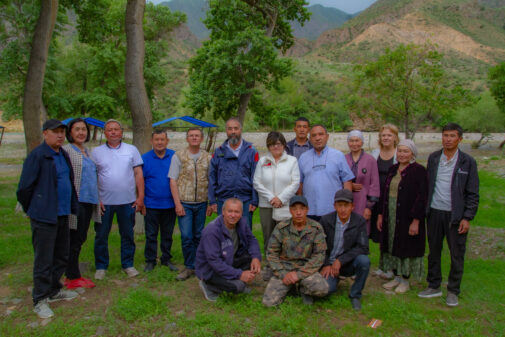
The Kassan-Sai KBA was selected as a pilot area in Kyrgyzstan. Since this KBA is not legally protected or designated as a reserve or national park, we believe in the importance of working in partnership with local communities and authorities in the Chatkal and Ala-Buka districts of the Jalal-Abad region to promote awareness and support for the conservation of key species. Kyrgyzstan’s GFC member groups will act as a safeguard for this KBA in collaboration with local activists.
To advance these goals, experts from GFC and the project team in Kyrgyzstan carried out a research expedition to the Kassan-Sai KBA in May 2022 and organized a seminar in the Chatkal district of the Jalalabad region called “Let’s Preserve the Natural Heritage of Kassan-Sai!” Participants discussed issues including the importance of biodiversity resources provided by the Kassan-Sai KBA to local communities; the benefits for communities of the sustainable use of the KBA; threats to the Kassan-Sai KBA, including gold mining; existing laws and regulations for the preservation of threatened biodiversity and KBA resources as well as human and environmental health; and possible solutions to problems.
They also explored opportunities for the development of green businesses (including ecotourism and hospitality) and sustainable development in local communities, and the use of valuable plants as genetic, ornamental and medicinal resources. The members of the team met with community groups involved in the development of local initiatives on forestry, such as tree nurseries, and other businesses.
And the struggle continues. The future initiatives proposed during the seminar include public environmental monitoring of soil and water, a group to identify and prevent illnesses related to mining, soil preservation and cleanup using biohumus, nurseries for endangered endemic plants, political advocacy to promote the inclusion of reclamation measures for abandoned mine sites into national legislation, raising awareness about environmental and social impact assessments by mining companies, ensuring design and implementation of Environmental and Social Management Plans, demanding the reclamation of old mines from the state, and trainings for the community on health and safety and environmental restoration and reclamation.
Local residents are not sitting idle, but rather, are working to protect endangered species, as expressed by Shabdrayimova Asylkan: “After the gold mining along the river, we have pits everywhere! Everything is dug up. And we have lost hope that the company will fix anything. Together with my husband, a forester, and hardworking residents, we are planting trees on the devastated lands. We improve the soil using local minerals and grow seedlings of rare wild apple and pear species. More recently, people started using the pits along the river for fish production, and it works well. We are not indifferent to the fate of our Terek-Sai land, the fate of Chatkal.”
Toktobayeva Buken, a teacher in Terek-Sai, says: “At school, we teach our children to respect nature, but it is being destroyed right before their eyes. Our efforts as teachers are diminished, but we do not lose hope. This fall, my students and I are going to collect the seeds of the Korzhinsky pear, listed in the international Red Book. This pear grows on a plot that a gold mining company could destroy with its excavations. Then, we will sow the seeds and create a nursery at our school. By doing this, we can save at least part of the valuable gene pool of this wild fruit plant and contribute to the conservation of forests.”
The Kassan-Sai KBA project aims to safeguard the area based on local community participation in decision-making and practical work on the sustainable use and management of living natural resources. We seek to build a model of self-governance at the local level focused on women and youth, who will be responsible with their land and natural resources and confident in fighting for their rights. This project is an example of how international and local activism, led by the communities affected by extractivism, can fight against the destruction created by human greed.
Agro-industrial monocultures as a form of extractivism: Oil palm in Liberia
By Ángel Tuninetti in collaboration with Rural Integrated Center for Community Empowerment (RICCE), Liberia
We are all avid consumers of palm oil, though we might not be aware of it; it is present in about 50% of the products we find in supermarkets, including ice creams, frozen pizzas, instant noodles, packaged bread, and cookies, to dog food, soap, deodorant, shampoo, toothpaste, and lipstick.
This ubiquity comes with a price: palm oil is one of the top causes of deforestation in the world. It is native to Africa but was brought to Southeast Asia through colonial expansion; now Malaysia and Indonesia supply more than 85% of the world’s production. This has a devastating effect on tropical rainforests as most production occurs on large-scale monoculture plantations that replace forests. With the ballooning of global demand, palm oil is bringing that extractivist devastation to Africa, posing threats not only to biodiversity but also to local populations—especially women, whose lives and livelihoods are thrown into upheaval by the plantations.
Biodiversity under attack
Liberia is home to some of the most biodiverse forests in the world, but they are currently under attack by palm oil encroachment in two regions: the Northwest and the Southeast.
The Northwest holds one of the largest remaining forest blocks in West Africa, a global conservation priority for its wealth of biodiversity and freshwater, and its importance as a carbon sink. Its carbon stocks are estimated to be among the highest globally, while its rich biodiversity includes critically endangered animals such as forest elephants and western chimpanzees. Gola Forest National Park, established in 2016, is one of the world’s priority biodiversity hotspots, with forests that connect several West African countries: Guinea and Sierra Leone in the west, and Côte d’Ivoire, Ghana, and Togo in the east. In addition, the forests are of vital importance for the livelihoods of millions of West Africans and provide key ecosystem services of local and global importance.
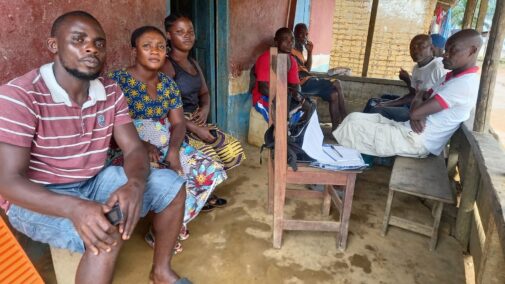
The landscapes in the Southeast consist of clusters of community forests, especially in River Gee County and Maryland County. This region is of great importance for local communities and biodiversity conservation, owing to the presence of Sapo National Park and Grebo-Krahn National Park. Sapo National Park is situated in Sinoe County. Spread over an area of 1,804 km², it is the country’s largest protected area as well as the second largest area of primary tropical rainforest after Taï National Park in neighboring Côte d’Ivoire. Grebo-Krahn National Park has been globally recognized as a biodiversity hotspot, protecting one of the largest populations of the critically endangered West African chimpanzee, the endangered pygmy hippopotamus, the vulnerable Diana monkey, western red colobus, forest elephant, leopard, and other threatened and endemic species. So far, about 300 species of fauna and 220 species of plants have been observed in the forest. Moreover, local communities that depend on forest resources for their livelihoods and wellbeing live within the boundaries of these protected areas.
The relationship between the state and the industry
The invasion of palm oil plantations is led by four companies: Sime Darby Plantation/Mano Oil Palm Plantation, Maryland Oil Palm Plantation (MOPP), Golden Veroleum Liberia (GVL), and Equatorial Palm Oil (EPO). While the companies allege that they have a commitment to sustainability, even seeking certification under the Roundtable on Sustainable Palm Oil (RSPO), all of them have been denounced for different violations of the rights of local people and environmental damage.
Malaysia’s Sime Darby Plantation, the world’s largest palm oil producer by acreage, signed a 63-year concession agreement with the Liberian government in 2009 to convert 220,000 hectares in northwest Liberia into oil palm and rubber plantations. However, due to many social, environmental, economic, and policy challenges, the company only planted about 10,300 hectares, and then sold the project to Mano Oil Palm Plantation.
The Maryland Oil Palm Plantation (MOPP) is one of the four major oil palm concessions signed with foreign investors by the Liberian government. The company is sponsored by SIFCA, a leading African agribusiness group based in Côte d’Ivoire that was founded in 1964 and operates in three main sectors: the cultivation, processing, and marketing of palm oil, sugar, and rubber, with a presence in four countries, Côte d’Ivoire, Ghana, Nigeria, and Liberia. According to the African Development Bank, MOPP aligns with national priorities. SIFCA claims that MOPP will help a fragile state to empower its rural population, and especially the youth and women, through job creation and entrepreneurship, to promote sustainable social and environmental practices, to contribute to infrastructure development, and to set the stage for more private sector investments in a post-conflict country.
However, there are reports of cases of sexual harassment and abuse perpetrated by senior and middle-management staff against women and girls working as contractors and casual laborers. Customary landowners were not consulted prior to land clearance for the plantation, and when they protested against the loss of their subsistence farming land, they were harassed and arrested by the Liberian National Police. As the company plans an expansion of their plantation, there is a need to investigate if primary forest areas have already been destroyed and/or if the planned expansion will affect primary forest and community livelihoods, and the destruction of sacred areas, including graveyards.
In 2010, Golden Veroleum Liberia signed an agricultural concession agreement with the Government of Liberia for 350,000 hectares for 65 years, renewable for 33 more years. Of this area, the company is permitted to convert 220,000 hectares into plantations and devote 40,000 hectares to an out-grower scheme. The concession agreement covers approximately 2.3% of the country’s land mass, spanning four counties in Liberia’s southeast. An estimated 41,000 people live within the immediate operations area, and the area is customarily owned and used by rural communities as a source of food and water. These communities are largely dependent on shifting agriculture, undeveloped water sources, and hunting and gathering in community forests for their livelihoods.
Since GVL began operations, communities and civil society have submitted multiple complaints to the RSPO, including intimidation and arbitrary arrests of community members, destruction of community wetlands, sacred areas, and drinking water sources. They are also accused of clearing land without receiving communities’ consent and not conducting comprehensive, participatory social and environmental impact assessments.
Equatorial Palm Oil was founded in 2005, and a Malaysian palm oil giant has been the majority shareholder since 2013. It has signed a ‘concession agreement’ with the Government of Liberia to develop and operate two large palm oil plantations: Palm Bay and Butaw. These agreements were made without properly consulting and gaining the consent of the communities who, for generations, have owned and used the land upon which these plantations are planned.
“We need our traditional medicines”: The widespread impacts of extractivism
Extractivism and the commodification of agriculture has led to multiple environmental and human rights violations in Liberia, particularly that of women. The most common violations are land grabbing, illegal dismissal and persecution of employees, failure of multinationals to fulfill commitments and obligations to communities, land and water pollution, deforestation, child labor, sexual harassment, and the absence of free, prior and informed consent. Also, governance practices and policies show various gaps, such as the lack of access to justice, weak redressal mechanisms for communities, and limited participation of local communities in decision-making, which is especially true in the case of women. To achieve an inclusive governance and sustainable management of local forest ecosystems, these challenges must be addressed. This requires well-coordinated and concerted effort, collaboration, and partnership with the government, civil society organizations, experts, and local communities/municipalities, with the meaningful participation of local women, elders and youth at every level/
The impacts are heavily gendered. As it often happens in the transition from traditional rural and forest economies to extractivism, women and elders are the most affected population: this is made clear in research conducted by the Rural Integrated Center for Community Empowerment (RICCE). For the project, RICCE interviewed and conducted focus groups with key informants, such as the District Commissioners, traditional leaders, smallholder farmers including both men and women (especially those involved with oil palm), principals of schools, women leaders and youth leaders in Sinoe, Grand Kru and Maryland Counties. The focus groups included women, youth, and local leaders.
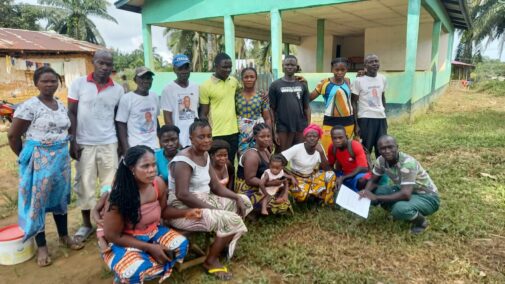
Local traditional practices and customs in Liberia have long denied women rights to land and decision-making relating to natural resources. In most of these remote villages, traditions, customs, early childbirth, and household work inhibit women from acquiring a high school education. Therefore, women’s limited access to information poses a hurdle when it comes to their land rights, and their participation in decision-making processes. Eighty percent of the town’s leadership are men, who are the primary recipients of information and the decision makers about the future of their lands.
However, most of the women indicated that they are breadwinners and guardians of the family; they have vast knowledge of sourcing and preserving traditional foods, traditional plant medicine, and the traditional farming system. This knowledge plays a major role in achieving sustainable food security and sovereignty.
Deforestation and land grabbing by the companies leads to the loss of farmlands, medicinal plants, firewood, and other forest products. They barely have enough farmland to produce food crops for their sustenance and are losing key elements of their culture. Christanal Saydee, a resident of Nyenpah, Sinoe County, said: “though there are modern medicines, they cannot cure all sicknesses—only some. We need our traditional medicines.”
While the companies promise jobs to women, those jobs are only available during the early stages of the plantation, specifically for planting and weeding. After that, most are dismissed, especially older women. There is no childcare nor washing facilities. At later stages in plantation work, more men are employed than women because work becomes more physically demanding. Women say they feel unsafe because they are not provided with protective equipment, and that if they are injured in the job, they receive no benefits. Occasionally they must work with dangerous chemicals without proper training, and they fear their health will be affected.
On top of everything, local residents have to endure unfair and sometimes brutal treatment by company and security forces. As a woman from Butaw County said, “our children are beaten by company and state securities for the alleged stealing of palm, and some for protesting to demand their rights.” Besides the testimonies collected by RICCE, these violations have also been reported by other organizations.
Hearteningly, things have improved in communities where there is ongoing formalization of customary land rights. In these communities, there is widespread awareness of women’s land rights, and they are even included in Community Land Development Management Committees, the body responsible for making decisions on land management and use, proving that access to land and the promotion and defense of women’s rights are a key factor in the struggle against the oppression of the unchecked expansion of extractivism. This offers a beacon of hope for the rest of the nation, and a model for a decision-making process led and monitored by women and indigenous people.
Violence against women, forced child labor: The realities of industrial mining in the DRC
By Ángel Tuninetti in collaboration with Programme Intégré pour le Développement du Peuple Pygmé (PIDP)

But the DRC’s biodiversity is threatened by the country’s other wealth: minerals. Since the beginning of this century, the country’s economy has been marked by mineral booms: coltan, cobalt, and now tin ore known as cassiterite, of which the DRC holds an estimated one-third of the world’s supply. Due to environmental laws enacted in Japan and the European Union in 2004 that forced lead-based solders to be replaced with tin, demand for coltan – and therefore its price – rose significantly. Tin prices have also tripled during the Covid-19 pandemic.
Bissie tin mine
One of the most important tin ore deposits lies at Bisie Ridge in the Walikale territory in North Kivu province. The deposit was discovered by residents in 2002, and a thriving artisanal mining industry emerged. By 2005, local communities had organized the Bangandula Association, to coordinate the mining and sale of minerals. The tin ore is sold to comptoirs, intermediary businesses that buy the unprocessed minerals extracted from the mines and then sell them to mineral processing companies. The largest buyer of minerals from artisanal mining in Bisie was Mining Process Congo (MPC).
The tin trade soon attracted bigger players like Alphamin Resources, a Canadian company headquartered in Mauritius. Since 2017, Alphamin has been developing the Bisie tin mine, a joint project with the Industrial Development Corporation of South Africa (which holds 14.25% of shares), and the DRC government (5% of shares). The project is expected to produce about 10,000 tons of tin a year.
As is often the case with the lure of extractivism, national and local governments bought into the promise of riches to be reaped from the project, with total disregard for the environment and local communities. Government officials have spoken of this project as the first of many to industrialize minerals in eastern DRC, suggesting that it would lead to more development in the region.
Alphamin is reporting record profits. However, the dream of boosting ‘development’ is far from being realized. The poor condition of the Goma-Walikale road hinders the transportation of minerals out of the mine, which affects production, and the region still lacks basic infrastructure such as schools and health centers.
Harm to communities
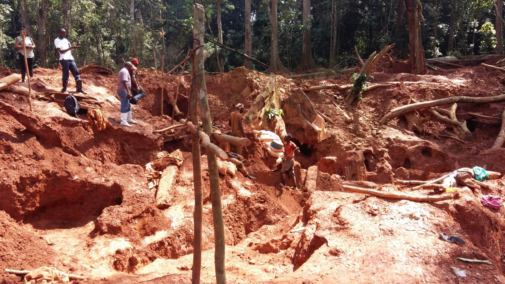
The impact on local communities, particularly Indigenous communities, does not end there. Representatives of the Banamwesi and Motodo Indigenous communities have complained of the harm they are suffering by contacting the National Alliance for the Support and Promotion of Indigenous and Community Heritage Areas (Alliance Nationale d’Appui et de Promotion des Aires du Patrimoine Autochtone et Communautaire, ANAPAC) and the Integrated Program for the Development of the Pygmy People (Programme Intégré pour le Développement du Peuple Pygmé, PIDP). They say they are victims of discrimination from Alphamin and their Bantu neighbors, who consider them socially inferior, and hence they were excluded from negotiations about the project.
Gender discrimination is also a factor, as there are few opportunities for women in industrial mining. If they are offered jobs, it is primarily as ore carriers and cooks for low-wage workers. Sex work is also rampant at the mining sites, and the absence of women in decision-making roles in the companies means that this goes unaddressed, with no steps taken to ensure women’s safety. Forced child labour and the exploitation of children is also common. Young girls are often victims of sexual violence, and coerced into early marriages. This also disrupts their education, trapping them in a cycle of poverty, violence, and discrimination.
While the company has procured agreements with representatives from the communities and national and provincial governments, there was little respect for systematic, free, informed, and prior consultation with the communities, who lacked technical support and access to information about the mining project. Even today, it is not known exactly how much land Alphamin has been granted access to, since they have never shared the mining permits with the communities. Worse yet, many communities like the Banamwesi, who were never consulted at all, have since 2019 found tracks and signs left by the company during prospecting and mapping in their communal forests.
Alphamin’s presence affects the cultural identity of the Tribes, restricts their access to local resources, brings infectious diseases to the region, destroys forest ecosystems that provide sustenance and have cultural and religious value, and erodes local land rights. There is also significant water and soil pollution, illegal game hunting to sell bushmeat to miners, and large-scale deforestation that contributes to climate change and biodiversity loss.
Legal violations
All of these practices violate not only DRC’s national legislation, such as the mining law, the forest code, and the land law, but also international conventions including the International Covenant on Civil and Political Rights, the International Convention on the Elimination of All Forms of Racial Discrimination, the Convention on Biological Diversity, and the UN Declaration on the Rights of Indigenous Peoples. Land was expropriated from locals without free, informed and prior consent, and no compensation was ever offered.
Women, Indigenous Peoples and local communities are the most important players in forest preservation and the battle against climate change. The women and the Indigenous communities of the DRC, and the forests they inhabit, are legally entitled to having their wellbeing protected and respected.
Fuelling Patriarchy and Poverty: The Role of Extractivism in the Destruction of Forest Ecosystems
By Chithira Vijayakumar and Valentina Martinez
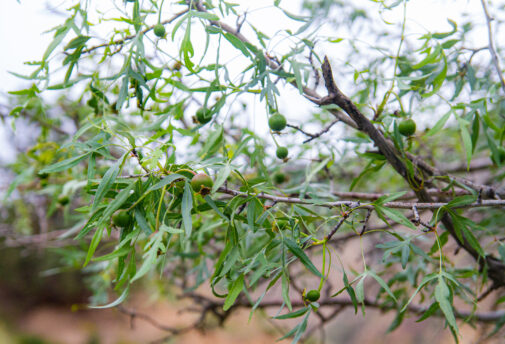
As the stories in this Forest Cover report show, extractive industries are an important driver of forest loss all over the world. These industries often argue that the destruction of some of the world’s most biodiverse ecosystems should be seen as a fair trade-off for the enhancement of human wealth. However, this report also shows that extractivism devastates people’s livelihoods, culture, and identity, rather than enhancing them. That is why it is essential to analyze extractivism as a driver of forest loss from a gendered perspective.
In June 2022, GFC invited expressions of interest from our member groups, grassroots organizations based in 72 countries around the world, to gather information about the gendered impacts of extractivism on forests in their regions. The six case studies finalized through this process represent a diversity in geopolitical considerations, as well as in the issues they were researching. The member groups spent weeks gathering data about the ways in which gender and Indigeneity intersect with the extractivist industries in their region, offering us a glimpse into a global industry that is estimated to account for more than 80% of the world’s biodiversity loss and over half of all global carbon emissions.
This issue of Forest Cover is a rare compendium of peoples’ accounts on living alongside an ecological resource that is highly prized by global capital, which also foregrounds the particular and often overlooked ways in which women and people of marginalized genders are impacted.
Subjugation and depletion
The case studies in this report are from Armenia, DRC, Ghana, India, Kyrgyzstan, and Liberia. Though the cases are evidently set in vastly diverse environments and regions, a clear pattern emerges in the relationship between the politics of extraction and the people and ecology in its impact zone.
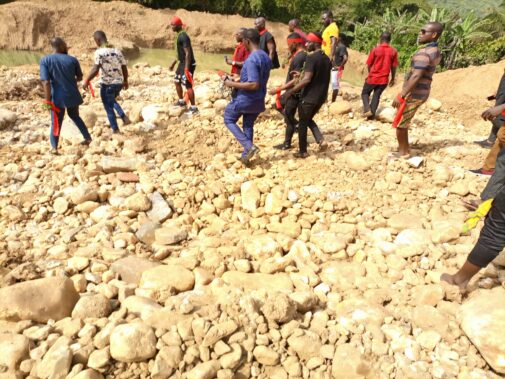
This is also echoed by Maristella Svampa and Enrique Viale, who state: “Given that the territories contain assets valued by capital, converted into commodities, an efficient vision was consolidated that considers them “socially empty” and, therefore, potential sacrifice zones. In the name of the ideology of progress, the communities and peoples settled there become invisible and/or “superficial,” the regional economies are devalued or their crises exacerbated. These processes of devaluation and violation of rights are enhanced in traditionally relegated regions, such as indigenous and peasant territories.”
This is reflected in the case study from Hasdeo Anand, India, as well. We see several tribal populations for whom the forest is a source of subsistence, medicine, and faith. They refuse to leave their forest which has several devgudis, sacred sites, and are forced to witness the clearing of 841 hectares of forest ecosystems for coal mining. The tribe is forcefully separated from their traditional cultural practices as well as their economic and political autonomy, which is characteristic of the colonialist nature of extractivism. The women, in particular, are made bereft of both their ways and means of living and also their fundamental right to life, as they are the primary interfacers with the forest through the collection of non-timber forest products and fuel wood. It is clear that we are dealing with “territorial hegemonies” and the “subalternization of regions,” as Héctor Alimonda describes when referring to Latin American extractivism, which conceives nature as a market.
Reifying patriarchal systems
Secondly, in these territories, the mechanism of late-stage extractive capitalism reifies and deepens existing patriarchal structures. For instance, palm oil, one of the main drivers behind the conversion of some of the world’s most biodiverse forests, has been encroaching steadily upon Liberia’s forest ecosystems and the agency and rights of the people who are dependent on them. In the case study from Liberia, we see that existing gender norms pose many challenges to women’s rights to education, land, and political and social decision-making. The local leadership is overwhelmingly male, greatly limiting women’s access to vital information and to ability to have a say in the future of the forests they help sustain.
This, of course, is not to say that women in all their diversities are passive observers of these decisions, but rather that their strides towards gender liberation are hobbled by the presence of global capital that engages largely with patriarchal structures alone. For instance, it is often the case that women come to know about deals signed by local leadership with the industry only after the agreements have been finalized.
The colonial legacy of extractivism
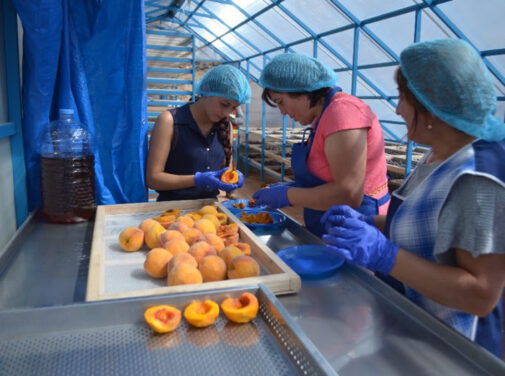
Likewise, Kyrgyzstan, despite its tremendous mineral wealth, has only 3% of jobs nationwide provided by extractive industries. In places like Ghana, we see a different pattern: locals do emphasize the importance of mining as a source of livelihood. However, with the influx of quick money from mining, the cost of living has climbed as well. In addition, their water sources have been contaminated, drug abuse and alcoholism have increased, and armed robberies and interpersonal violence have been clocked to be on the rise. So while there is an infusion of cash into the local economy, it is concentrated in the hands of men, while the heavy social and political costs have to be borne by the women. There is also little to no support available to them from the national and transnational entities that benefit from these industries. In fact, even women who have been employed by extractivist industries have spoken about how they are relegated to low-paying jobs, of medical compensations in the case of injuries on the job being meted out only to men, and how even when they do the same work as men, they are paid much less owing to a significant wage gap.
It is important to note here that industrial mining is an outlier when it comes to women’s participation—studies have shown that things are very different when it comes to artisanal and smaller-scale mining. For instance, in the Andean region, mining is one of the main economic activities, generating income and foreign exchange: “However, the direct jobs it generates are heavily dominated by men. Female labor participation in mining in Andean countries is far below that in other mining areas. It should be noted that in several countries of the subregion, this trend is reversed in artisanal and small and medium-scale mining: one example of this is Colombia, where female participation stands at 70%.” This is echoed in the case studies in this report as well—in places like DRC, we see the increasing displacement of artisanal mining by large-scale industrial mining, indicating a trend of increased marginalization and exploitation of women in all their diversities.
The rise of gender-based violence
Finally, it has been well-documented globally that extractivist territories are sites of rising gender-based violence, including sexual assault, domestic violence, trafficking, adolescent pregnancies and forced marriages, with Indigenous women impacted at disproportionately high rates. This is confirmed in this report as well. In Hasdeo Anand, the member groups point to how mining in the region has steadily eroded the rights of tribal women, as well as increased sexual abuse and alcoholism. In DRC, the rising number of forced marriages and adolescent pregnancies have meant a disruption in the education of girls, trapping them in a cycle of poverty, violence, and discrimination. The Environmental and Social Impact Assessment of the mining project in Jermuk acknowledges that there is likely to be an increase in criminal activity and sexual violence in the town, owing to the large numbers of male workers who will come from other regions.
And yet, this rising gendered violence often warrants little response or even acknowledgment by the extractivist industries: none of the member countries found evidence of companies having paid any attention to the rampant harassment and sexual exploitation in their extractivist zones. Communities are left to absorb these violences and asked to accept them as part of ‘business as usual’ as opposed to the severe social, political, and public health crisis it really is. Shrinking public and civil society spaces for women and people of other marginalized genders strengthen the capitalist, colonial, and patriarchal system that extractive industries need to continue their mode of operations. Under extractivism, both nature and women’s bodies are violated and degraded in such a way that the continuity of life with dignity is made impossible.
The leadership of rural and Indigenous women
In conclusion, the articles in this issue of Forest Cover reveal a shared reality about the degradation of forest ecosystems: the myth of extractivism for economic “development” and its particularly gendered impacts. This productivist vision of development has paved the way for the implementation of extractivist projects in natural sanctuaries all over the Global South, causing human rights violations, displacement of Indigenous peoples and local communities, impacts on health and food sovereignty, economic and social inequalities, as well as environmental problems. This is especially prevalent in rural areas, where climate change, deforestation, loss of water sources, and land degradation threaten local livelihoods, culture, and identity. Industrial extractivist systems necessarily cast women and people of other marginalized genders in the role of the ‘Other,’ taking away their agency. But we also see that women, especially Indigenous and rural women, have been at the forefront of resistance against industrial extraction, and are increasingly refusing to be caught up in the endless cycles of exploitation. They are speaking out against capitalism, colonialism, and patriarchy, and without recognizing their leadership, there is no way out of the planetary ecosystem collapses that we are now faced with.
Acknowledgments
Editorial Team:
Allie Constantine, Ángel Tuninetti, Chithira Vijayakumar, Juana Vera Delgado, Kwami Kpondzo, Megan Morrissey, Simone Lovera, Valentina Figuera Martínez, Wen Bo
Lead Author:
Ángel Tuninetti
Editors:
Allie Constantine, Chithira Vijayakumar, Don Lehr, Megan Morrissey
Translators:
Amira Armenta, Danae Serinet Barrera, Elena Kreuzberg, Gaelle Le Gauyer, Megan Morrissey, Rachel Babin
Design:
This publication has been produced with support from Women Engage for a Common Future (WECF) through the Green Livelihoods Alliance (GLA), financed by the Dutch Ministry of Foreign Affairs, the American Jewish World Service and the Swedish Society for Nature Conservation (SSNC). The contents of this publication are the sole responsibility of the Global Forest Coalition and can in no way be taken to reflect the views of donors.

